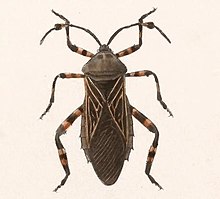| Thasus gigas | |
|---|---|

| |
| Thasus gigas (female) | |
| Scientific classification | |
| Domain: | Eukaryota |
| Kingdom: | Animalia |
| Phylum: | Arthropoda |
| Class: | Insecta |
| Order: | Hemiptera |
| Suborder: | Heteroptera |
| Family: | Coreidae |
| Subfamily: | Coreinae |
| Tribe: | Nematopodini |
| Genus: | Thasus |
| Species: | T. gigas |
| Binomial name | |
| Thasus gigas (Klug, 1835) | |
Thasus gigas is a species of leaf-footed bug in the family Coreidae. It is found in Central America and North America.

Habitat
T. gigas is often found in Prosopis or Acacia Trees.
Behavior
T. gigas is diurnal, and thus mostly active during the day.
Development
Unlike insects that undergo complete metamorphosis, hemimetabolous insects like T. gigas do not have a pupal stage. Instead, the nymph stage resembles the adult stage, but without wings or functional reproductive organs.

References
- "Thasus gigas Report". Integrated Taxonomic Information System. Retrieved 2019-12-26.
- "Thasus gigas". GBIF. Retrieved 2019-12-26.
- Webb, Nick; Eades, David C. (2019). "species Thasus gigas (Klug, 1835)". Coreoidea species file online, Version 5.0. Retrieved 2019-07-02.
- "Global Biotic Interactions (Thasus gigas)". Retrieved 2023-06-02.
- Lewis, T.; Taylor, L.R. (1965), "Diurnal periodicity of flight by insects" (PDF), Transactions of the Royal Entomological Society of London, 116 (15): 393–435, doi:10.1111/j.1365-2311.1965.tb02304.x
- Belles, Xavier (2011), "Origin and Evolution of Insect Metamorphosis", Encyclopedia of Life Sciences, John Wiley & Sons, Ltd, doi:10.1002/9780470015902.a0022854, ISBN 9780470016176, S2CID 43922496
Further reading
- Brailovsky, Harry; Schaefer, Carl W.; Barrera, Ernesto; Packauskas, Richard J. (1995). "A revision of the genus Thasus (Hemiptera: Coreidae: Coreinae: Nematopodini)". Journal of the New York Entomological Society. 102 (3): 318–343. JSTOR 25010094.
External links
 Media related to Thasus gigas at Wikimedia Commons
Media related to Thasus gigas at Wikimedia Commons
| Taxon identifiers | |
|---|---|
| Thasus gigas | |
This Coreoidea article is a stub. You can help Misplaced Pages by expanding it. |